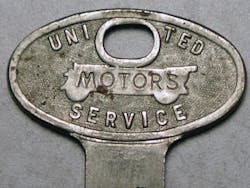10 Years Ago
Exit Alarms were on the cover of the September 2001 issue of Locksmith Ledger. Dick Zunkel wrote about the Evolution and Applications for Exit Alarms. Tim O’Leary addresses building codes and legal issues regarding exit devices and alarms. Jerry Levine reported on a retrofit installation of the Precision Hardware 1100 Apex Rim Exit Device. Jerry Levine and Gary Williams converted a Von Duprin 99 rim exit device to an exit alarm. Another installation article asked the question: “Which access control device is right for your application – electric strike, electromagnetic lock or electromechanical lock?” A-1 Security introduced the Mean Green code cutting punch machine. Tom Gillespie gave some marketing advice in the article “Tips on Running a Lock Shop, Part 2: Colleagues and Competitors.” Richard Formica serviced the 1999-and-up Land Rover Discovery.
20 Years Ago
Automotive Locksmithing was the cover theme for the September 1991 issue of Locksmith Ledger. Stephen Sharpe reported on opening three 1991 model Toyota vehicles, considered among the toughest cars to open at that time. A1’s KCAD=500 PassKey Decoder for GM keys was also featured. Charles Cole wrote about Auto Lock Servicing Tricks. Gale Johnson covered Tryout keys for Chryslers. Bill Neff wrote an installation article on the Marlok Solitaire rim-mounted exit device. “Traditional mechanical door hardware is not going to simply go away in the face of ‘futuristic’ developments such as electrified locksets, exit devices and access control systems,” Sargent’s Rod Lincoln predicted in his Wired for the Year 2000 article. Milt Wolferseder opened a Safeguard Safe and C. Allan Halvorsen discussed safe repairs after penetration.
CODE WORK IN THE 1930s
Back in the roaring 1920s most car locks used pin tumbler locks made by companies such as Sargent, Yale, Russwin and Eagle. Since there were no HPC, Framon or Ilco code machines at the time, locksmiths had to find their own methods for originating keys. One company, United Motors Service, actually made key blanks with depth and space lines marked on the blank. Locksmiths with an impressioning file and a sharp eye could file an operating key in minutes.
By the 1930s several manufacturers of locks also made code machines for originating their keys. One such machine was made by Briggs & Stratton. A set of space keys was available for every lock type made by B&S and a micrometer on the machine could be set for the required depth. The B&S machine was a forerunner to the Foley Belsaw machine which used a similar micrometer depth setting system.






